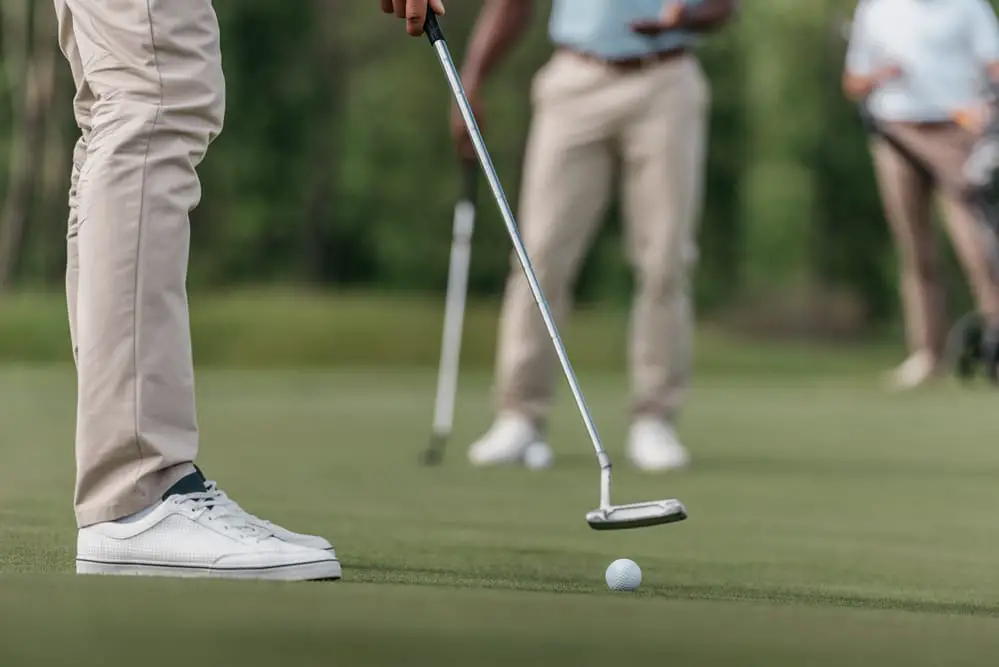Last Updated on October 20, 2023
Golf is a game that requires both skill and technique. To be successful on the golf course, one must learn to swing their club in a consistent manner so as to hit the ball accurately. A key component of this motion is staying on plane with the swing throughout its duration. This article will offer tips for how to stay on plane in a golf swing effectively.
What Is A Plane?
In golf, a plane is an angle at which the swing is taken. This angle can be thought of as an imaginary line that runs through your arms and shoulders in order to keep them connected during the swing. The goal is for this imaginary line to remain parallel or slightly inclined throughout the entire swing, allowing you to stay on plane. Properly staying on plane helps ensure that each shot will have maximum accuracy and distance.
The concept of maintaining a consistent plane angle has been used by professional golfers for decades and is considered essential for achieving good results with any type of golf club. To do so requires understanding proper mechanics related to posture, alignment, grip, and backswing movement. When combined correctly with good timing and balance, these elements help create an efficient motion that stays on plane from start to finish for better ball striking.
Stance And Posture
Staying on plane in a golf swing is largely dependent upon the golfer’s stance and posture setup. A player must ensure that their feet, hips, shoulders and arms are all parallel to the intended target line when setting up for the shot. This alignment ensures that the body remains in balance throughout the swing as it moves along an imaginary plane. Improper posture can lead to shots being hit off-plane, resulting in poor directional control of the ball.
Having a good golf stance and posture requires practice in order to become consistent with your game. It is important to stand behind the ball with your feet shoulder-width apart while maintaining flexion at your knees so they do not lock during your swing. The spine angle should remain unchanged from address position through impact zone; this will create a stable base for you to launch each shot correctly without too much effort or manipulation of your body parts during the backswing or downswing. Additionally, when practising proper swing posture, make sure that your head stays still relative to where it was at address rather than allowing it to move towards or away from your target line, as this may cause additional off-plane issues.
In order to maximize success while staying on plane, consistency is key; having a solid pre-shot routine consisting of effective stance and posture setup will provide stability within your swings, thus ensuring better control over the trajectory and direction of each shot taken.
Grip And Set Up
Grip and Set Up are essential components of a successful golf swing. To ensure proper setup, the golfer must take hold of their club in the correct manner. The dominant hand should be placed on the bottom part of the grip nearest to the head of the club, with fingers spread out across it. The other hand should be positioned above, encircling the first one firmly but not too tightly. This will help create even pressure throughout both hands during the swing.
The feet should then be placed shoulder-width apart for stability and balance. As such, this allows for maximum power transfer from the lower body to the upper body as well as ensuring that all parts work together efficiently in order to generate speed through impact and, ultimately, distance off the tee. It is also important to make sure that your stance lines up correctly with your target line so you can ensure good accuracy when striking down into the ball.
Once these fundamentals have been established by establishing a solid grip and setup posture, a player can confidently move on to addressing their ball and making a successful shot.
The Backswing
Having an effective grip and set up is the foundation for a successful golf swing. Continuing on to the backswing, it is important to stay on plane in order to maximize power and accuracy.

To achieve this, focus on three fundamentals:
- Maintaining good posture throughout your backswing
- Using your arms correctly
- Keeping your head steady during the entire movement
Good posture can be maintained by keeping your weight centred over the balls of your feet when completing the takeaway, with the clubhead staying along its original path until reaching waist-high. This ensures that you are not swaying from side to side, which could lead to losing balance or making contact with the ball off-centre. Additionally, utilizing correct arm movements will help keep you on plane, as having too much wrist action during this phase can cause inconsistent shots. Lastly, holding your head still and maintaining eye contact with the ball is key; any excessive motion of your head may add unnecessary elements to your swing, causing shots to veer off course.
The best way to ensure proper technique when executing a backswing involves performing various drills designed specifically for this purpose. Practice swinging at different speeds while focusing on each fundamental separately, then combine them all together so they become second nature when addressing the ball out in play. Incorporating these basics into your routine should result in more consistent strokes and ultimately, lower scores.
The Downswing
The downswing is the second part of a golf swing and arguably one of the most important. Proper mechanics in this motion are crucial for achieving optimal ball flight and distance control. The timing of the downswing should be initiated when the club head has reached its highest point, with the arms, shoulders, and body all working together to create an efficient path through impact.
To maintain plane throughout the downswing, it is important to keep your weight moving towards the target during the transition from backswing to downswing. This will help ensure that your hands remain on the same plane as they travel downwards. Additionally, use your left arm (for right-handed players) as a guide for controlling the swing path and keeping everything on plane. Doing so will enable you to generate power without sacrificing accuracy or consistency.
Thus, proper downswing mechanics combined with correct timing and a controlled swing path are essential components for maintaining a consistent plane throughout the entire golf swing. Keeping these elements under control can greatly improve ball striking ability while helping maximize performance potential on every shot.
Impact Position
Following the downswing, it is important to move into an impact position that reflects the previous swing plane. This will ensure accuracy and power in each shot. In order to do this, there are a few key points to consider when swinging.
| Golf Swing | Impact Position |
|---|---|
| Keep your head behind the ball all the way through | Left arm should be straight at address with elbow slightly flexed during impact |
| Maintain shoulder turn throughout backswing and follow-through | Right arm should be close to body but not touching chest at impact |
| Weight shift towards target on downswing | Clubface should point up and left of target line at impact (for right handed players) |
The golf swing must remain on plane for optimal results. If the golfer’s arms collapse too early or if their hands flip over prematurely, then they risk losing power and accuracy. Additionally, staying connected from the top of the swing until contact helps keep clubhead speed up as well as maintain control of where the ball goes. To help achieve this goal, focusing on driving off the inside heel while maintaining good posture can help create a more consistent setup position leading into impact. Keeping these tips in mind will allow golfers to stay on plane throughout their entire golf swing, which leads to greater success on every shot.
Common Mistakes
When attempting to stay on plane in a golf swing, it is important to recognize and avoid common mistakes.
The following are three of the most common errors when trying to maintain a single plane:
- Over relying on your arms: When swinging, many individuals tend to rely too heavily on their arms rather than letting their body rotate through the shot. This can cause the clubhead to move off plane as you transition into your downswing.
- Poor posture at address: Setting up with poor posture will lead to an inconsistent backswing and make it difficult for you to return the club in its original position. It’s essential that before every swing, you establish correct posture and positioning so that each time you take the club away from the ball, it returns to its original starting point.
- Not using your core muscles properly: Your core muscles play a vital role in maintaining balance throughout your swing and keeping the clubface square during impact. If these muscles aren’t used correctly, then it becomes more difficult for you to control where the clubface is pointing when hitting shots.
It’s paramount that golfers become aware of these common mistakes and work diligently towards correcting them if they want consistent contact while staying on plane in their golf swings.
Conclusion
In summary, a proper understanding of how to stay on plane within a golf swing is crucial for optimizing one’s results out on the course. Regularly practising this fundamental movement pattern will enable golfers to develop consistency within their swings and vastly improve their overall game performance.


